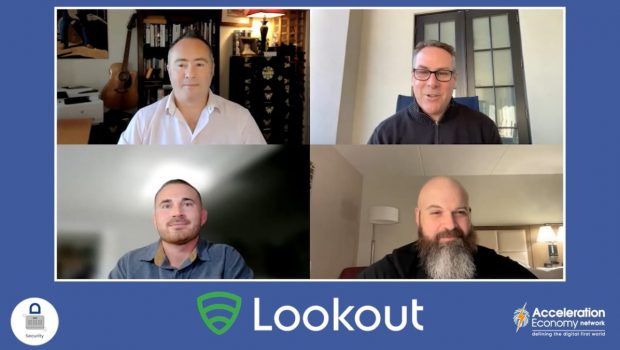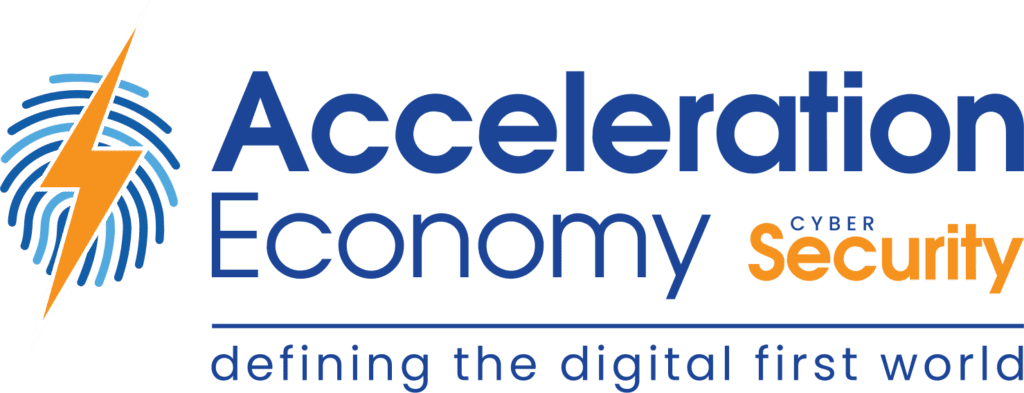Why Lookout’s Mobility-First, Endpoint-to-Cloud Approach Is a Key Cybersecurity Differentiator
In this Cybersecurity Channel special report, Acceleration Economy Co-Founder John Siefert is joined by Acceleration Economy VP/Principal Analyst Aaron Back, Acceleration Economy Analyst and CISO Chris Hughes, and Lookout Chief Strategy Officer Aaron Cockerill. Lookout was recently named one of the “Cybersecurity as a Business Enabler Top 10” companies. Cockerill describes what Lookout does, its origins as a mobile security company, and why that’s a key differentiator versus the competition, the future of ransomware breach detection, and the role that partners and integrations play in the company’s solutions.
Highlights
01:36 — Aaron Cockerill explains that Lookout started as a mobile security company, but expanded its services beyond mobile devices a few years back. The company has “evolved into business enablement” because it is now able to determine, at a much more granular level, potential risks at the endpoint (someone else’s computer, a hotel network, or a public network, for example). Using this assessment, in combination with an analysis of how sensitive data may be, Lookout technology is able to make a balanced decision on what a user’s access should be — and how they can access it. Rather than blocking access entirely, Lookout technology requires that users always authenticate in order to access any information. The ability to authenticate can always be removed, if necessary.
04:13 — Chris notes how innovative Lookout is. The company’s technology is “touching the future” of where the world is heading with zero trust — bi-directional, context-based access (what device, where is it connecting from, what time of day, and so on). Lookout analyzes multiple factors that contribute to making dynamic access-control decisions so the company can enable other businesses to keep operating under the right context with proper security access.
05:04 — Aaron Back notes how powerful Lookout’s efforts are for two reasons:
- Lookout was born out of the mobile aspect and applies a mobility-first approach.
- Lookout has a dynamic aspect of geographical access.
Lookout’s security devices are connected to the apps that businesses rely on. The organization works to implement security measures on the front end of applications, ensuring there is a protective layer around the data stored in applications. He notes that the balance between too much access and too little access is critical, because if someone does not have enough access to the correct data at the right time can lead to bad business decisions.
07:21 — John notes Lookout’s “endpoint to the cloud and cloud to the endpoint” strategy that is built into the business. He asks Aaron Cockerill to expand on that strategy.
07:35 — Aaron Cockerill says it is clear that everybody has an understanding of the endpoint context. Lookout believes there are three things to be taken into account in more detail than most of the solutions providing this type of access:
- Geographical context
- The responsibility of the device
- A clear understanding of the individual identity
Cockerill notes the different security implications that come into play when using a mobile device versus a desktop, since different apps are accessed on mobile devices versus desktops.
09:19 —Simplicity and consolidation is important today, says Aaron Cockerill. Something that differentiates Lookout from other cybersecurity companies is that in its proxy architecture, the company runs access to all of a company’s private applications, cloud applications, and the internet. Personally identifiable information (PII) only needs to be entered once, which will control the PII across all of these paths, no matter if it’s a private application, a SaaS application, or even a user who happens to have the data at the endpoint. Aaron Cockerill notes the importance of Lookout’s efforts in securing cloud applications from a single proxy architecture standpoint to simplify the data policy and control.
10:26 — Aaron Back suggests that Lookout’s approach helps different industries with specific data types and needs, which adds an extra layer of industry focus.
11:11 — John adds how specific industries need to take the “why and how context for cybersecurity as a business enabler” and bring it to their industry because of federal regulations.
12:06 — The “conduit of access” that Lookout ensures through its single proxy approach to make determinations around access is critical, says Chris. The innovative capabilities of Lookout’s solutions are very promising.
12:54 — John asks Cockerill, who has spent a lot of time with customers, what he is hearing from them as well as how that is influencing and guiding “some of the road-mapping from Lookout.”
13:54 — Cockerill explains how customers are commenting on the promise of extended detection and response (XDR) but the difficulty of implementing it. The industry has been badly hit by ransomware over the past couple of years, and ransomware is primarily about data exfiltration. The best time to detect bad actors who are trying to get access to data is during the process of data exfiltration, which can happen over a matter of months. The Lookout team believes that there is an interesting opportunity for it to be included or even at the forefront of XDR since the telemetry of access is going to be the most valuable factor in the implementation of XDR. The company is working on ways to enable customers to detect and potentially report data exfiltration as it happens, which will help with detection.
16:16 — Chris echoes Aaron Cockerill’s remarks, noting that “the telemetry of access is going to be indicative of the behavior going on in an environment.” He notes that Lookout’s origins in the mobile workspace are an advantage today in particular, since “now we have a mobile workforce,” and the company is “used to operating in that environment.” This is Lookout’s key differentiator and is what is “really giving them a lot of value here.”
17:48 — The behavioral analysis Lookout applies to its solutions is critical, notes Aaron Back, since threats are both external and internal. In order to help mitigate unintentional risks from happening from an internal standpoint of an organization, for example, then “putting things in place to help as guardrails,” is crucial. These include not only optimizing data access in smart and strategic ways, but also developing methods to keep unintentional mistakes, which also bring risk, from happening.
19:03 — Lookout is optimizing the “real-time ability” to make sure that the sensitivity of data is actually defining the policies and processes that are in place for access, says John.
19:19 — Aaron Cockerill adds that partnerships and integration, particularly with data classifiers, are a key part of what the company offers since most companies have sensitive customer or intellectual property data and they’ve typically “gone to great lengths to classify that information.” Lookout’s extensive integration with classifiers means that “you don’t have to reinvent the wheel.” He reiterates the importance of partnerships and integration, since no single security company can do classifiers alone.
20:17 — Chris notes how refreshing it is to hear a vendor talk about its rich ecosystem of partners and integrations.
20:34 — In 2023, Acceleration Economy will be leading four digital summits that demonstrate how partners ecosystems support Lookout and other companies in creating partnerships that enable these things to happen for businesses.
Want more cybersecurity insights? Subscribe to the Cybersecurity as a Business Enabler channel:









Gloss